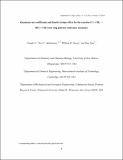Quantum Rate Coefficients and Kinetic Isotope Effect for the Reaction Cl + CH[subscript 4] → HCl + CH[subscript 3] from Ring Polymer Molecular Dynamics
Author(s)
Li, Yongle; Green, William H.; Guo, Hua; Suleymanov, Yury
Download5.pdf (2.775Mb)
PUBLISHER_POLICY
Publisher Policy
Article is made available in accordance with the publisher's policy and may be subject to US copyright law. Please refer to the publisher's site for terms of use.
Terms of use
Metadata
Show full item recordAbstract
Thermal rate coefficients and kinetic isotope effect have been calculated for prototypical heavy–light–heavy polyatomic bimolecular reactions Cl + CH[subscript 4]/CD[subscript 4] → HCl/DCl + CH[subscript 3]/CD[subscript 3], using a recently proposed quantum dynamics approach: ring polymer molecular dynamics (RPMD). Agreement with experimental rate coefficients, which are quite scattered, is satisfactory. However, differences up to 50% have been found between the RPMD results and those obtained from the harmonic variational transition-state theory on one of the two full-dimensional potential energy surfaces used in the calculations. Possible reasons for such discrepancy are discussed. The present work is an important step in a series of benchmark studies aimed at assessing accuracy for RPMD for chemical reaction rates, which demonstrates that this novel method is a quite reliable alternative to previously developed techniques based on transition-state theory.
Date issued
2014-02Department
Massachusetts Institute of Technology. Department of Chemical EngineeringJournal
The Journal of Physical Chemistry A
Publisher
American Chemical Society (ACS)
Citation
Li, Yongle, Yury V. Suleimanov, William H. Green, and Hua Guo. “Quantum Rate Coefficients and Kinetic Isotope Effect for the Reaction Cl + CH[subscript 4] → HCl + CH[subscript 3] from Ring Polymer Molecular Dynamics.” The Journal of Physical Chemistry A 118, no. 11 (March 20, 2014): 1989–1996.
Version: Author's final manuscript
ISSN
1089-5639
1520-5215